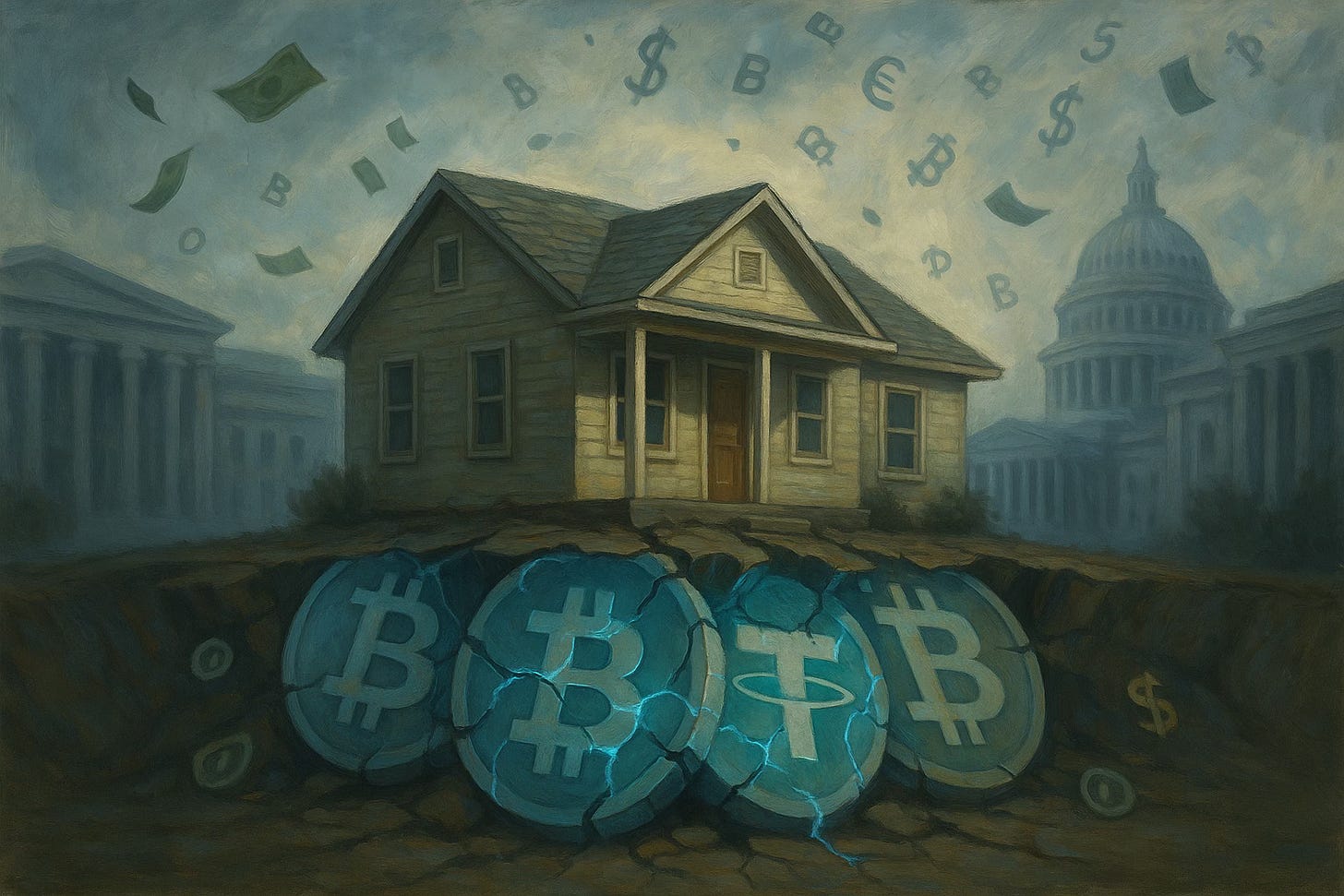Stablecoins and Mortgages: A Risky Experiment
Importing crypto’s volatility into federally backed credit.
On June 25, 2025, FHFA told Fannie Mae and Freddie Mac to draft rules that let cryptocurrency sit beside cash and Treasurys in mortgage files. Not trivia—those two touch roughly half of U.S. mortgages, a ~$12 trillion market where families live and die by basis points.
Treat tokens like equities, slap on a haircut, move on? That's the sales deck. The story that matters is model risk—the plumbing that breaks when a 24/7, thin-liquidity asset class gets wired into federally backstopped housing credit.
The August 7 executive order on 401(k)s widened menus for optional alternative allocations under fiduciary gates. Uptake depends on plan sponsors and litigation risk; most savers won't touch it. This is different. Letting crypto into underwriting changes how mortgage credit gets modeled and margined. Investment choice vs. core collateral math. Very different blast radius.
Volatility isn't a moral failing; it's design: reflexive liquidity, fragmented venues, opaque leverage, retail-driven flows, microstructure that rips at 2 a.m. Eastern.
Now marry that to fixed-rate mortgages, prepayment convexity, and MBS pipelines juggling rate locks, pair-offs, and TBA hedges. If collateral inputs can gap 20% over a weekend, "adequate reserves" becomes a timestamp problem. An underwriter freezes a PDF on Tuesday; by Friday a bridge gets drained or an exchange halts withdrawals. Monday the "asset" is a screenshot.
"The more that crypto gets integrated with mainstream financial products, the more that the risks of that market aren't just quarantined to people who choose to invest in crypto. They can become everybody's problem."
— Amanda Fischer, Better Markets
Stablecoins don't save it. Pegs crack when redemption confidence cracks. Tether slipped in 2022; USDC traded down ~13% during the SVB panic in March 2023. In a stampede, "$1" trades at $0.87, and now a warehouse lender and a GSE rep argue about who eats the slippage.
Security isn't a footnote either. In the first half of 2025, reported exploits and thefts ran into the billions—roughly $1.5 billion at Bybit and ~$400 million at Coinbase were widely cited. Even with a 50–80% haircut, one custody incident can vaporize reserves right when a borrower hits a job wobble. Timing correlation kills.
The Numbers That Matter
Scope: ~$12,000,000,000,000 mortgage market; GSEs touch ~50%
Trigger: June 25, 2025 directive to count crypto in underwriting
Conflicts on paper: crypto holdings disclosed in mid-six to seven figures; miner equity in the eight-figure band
Consumer pushback: Aug 14, 2025 advocacy-group letter calling the plan a "house of cards" risk
Security bleed: ~$1.9B reported across two big venues in 1H25
Sensitivity: 60% haircut + 30% weekend drawdown = half the "reserves" gone
Two routes exist. Crypto as reserves: survivable if haircuts are savage, custody is U.S.-regulated, and valuation is real-time. Crypto as income—counting staking yield or trading gains in DTI—is a grenade. One parks volatility in buffers; the other wires it into cash flow. Drawdowns don't ask permission.
Board reshuffles left the same chair presiding over both GSEs while they remain in conservatorship—unusual by any standard. Public disclosures list personal crypto stakes; family ventures span mining and DeFi. Critics say that mix raises conflict-of-interest concerns when policy touches digital assets. Agencies describe recent referrals in mortgage-fraud cases as routine enforcement; critics see hardball. The incentives debate won't disappear.
Adoption in plain-vanilla mortgages is thin. Down payments sourced from crypto are rare; audited on-shore custody rarer. Practical outcome: a narrow slice of high-net-worth token holders gets better terms, while tail risk is socialized through the GSEs.
Heads they win; tails the model pukes.
Make It Boring or Don't Do It
Minimum guardrails if this moves forward:
Only U.S.-regulated custodians
On-chain proofs tied to named accounts
Intraday margining
Nuclear-grade haircuts
Zero credit for staking/trading income
Automated lockouts during volatility halts
The mortgage funding stack wasn't built for collateral that gaps while New York sleeps. That's the plumbing problem.
Pick stability or sizzle. Both don't fit inside a conforming loan file.


